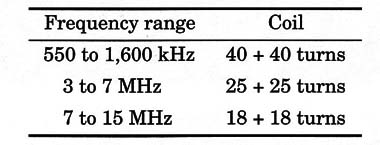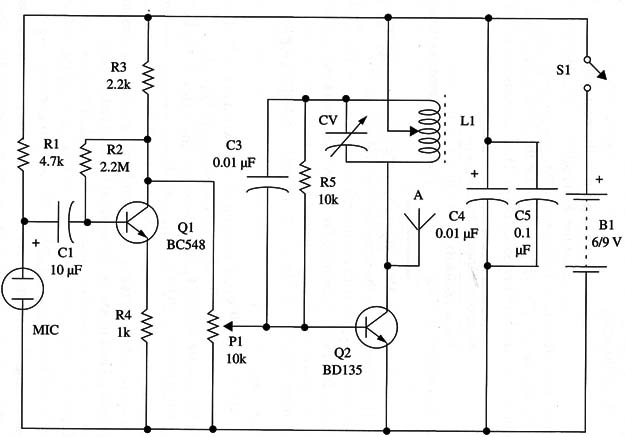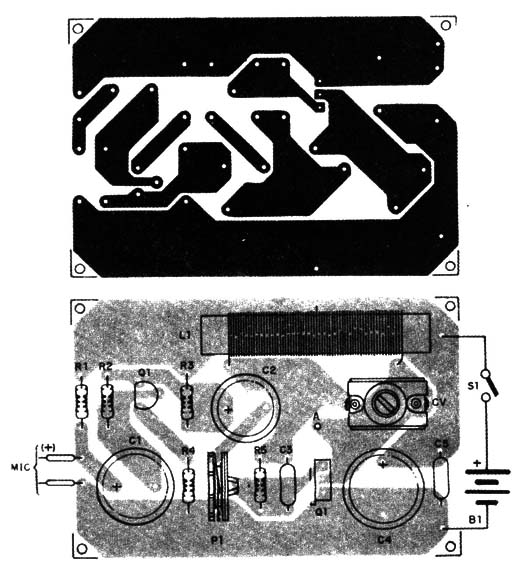Features
Power supply voltage: 6 V to 12 V
Frequency range: MW 530 to 1,600 kHz
SW1 3 to 7 MHz
SW2 7 to 15 MHz
Range: up to 150 ft (depending on frequency)
This transmitter is powered from common AA cells and can send signals both in the MW range and the SW range, depending on the coil. Also depending on the coil (and the frequency range), the signals can be sent to receivers placed at distances up to 150 ft.
The circuit can be used as a wireless microphone, a mobile transmitter for short-range communications, and for demonstrations and experiments in technology education. A small, home-based MW radio station can also be made with this circuit.
How It Works
The circuit is formed by two stages: a modulation amplifier stage and a high-frequency oscillator. The modulation stage picks up the audio signals from an electret microphone. One transistor in the common emitter configuration is used in this stage.
Resistor R1 biases the electret microphone, and R2 biases the transistors base. Depending on the transistor gain, you must experiment with the value of resistor R2 in the range between 470,000 and 2,200,000 ohm to obtain the best performance without distortion.
The signals amplified by this stage are applied to the next stage by capacitor C2 and potentiometer P1. P1 can adjust the modulation level to find best performance.
The high-frequency stage is a Hartley oscillator, and its frequency is determined by L1 and adjusted by CV. Three options for the coil are suggested to the reader according to the choice of frequency range. These options are as follows:

In many cases, you will need to add or reduce the number of turns in the coils to find the correct range.
All of the coils are formed by AWG 26 to 28 enameled wire on a ferrite core 4 to 10 in. long. The diameter is in the range between 1/4 and l/2 in.
CV is any variable capacitor with capacitances in the range of 120 to 360 pF.
Any variable capacitor found in an old MW or SW transistor radio can be used.
Altematively, a trimmer capacitor can be used for this project.
The signal can be conducted to the telescoping antenna from the transistor collector or, if you intend to use an external antenna, from a second coil wound over L1. This coil can be formed with 5 to 10 turns of AWG 28 enameled wire.
Assembly
A schematic diagram of the MW/SW transmitter is shown in Fig. 1.

The components are mounted on a printed circuit board as shown in Fig.2.

Details about the coil are given in the previous section (“How It Works”). The printed circuit board is intended for the use of a trimmer capacitor (between 2-20 and 8-80 pF), but the layout can be altered to accept a variable capacitor.
All capacitors with values below l µF are ceramic. For values above that level, the components are electrolytic capacitors rated to 12 WVDC or more. The reader must take care when mounting the electrolytic capacitors, as they are polarized components. Their proper positions must be observed.
Transistor Q2 must be installed on a small heat sink. This heat sink can be made from a 1 x 2 in. metal plate bent to forma a “U” and aflixed to the transistor by a screw. Equivalents for Q2 are the BD137, BDl39, or any other medium-frequency transistor with a frequency transition near 50 MHz or higher.
The antenna can be a piece of plastic-covered wire 10 to 40 in. long or an external antenna as described for the other shortwave transmitters in this book.
A telescoping antenna can be installed if the circuit will be used for short-range communications or as an experimental radio station.
The circuit can be powered from 6 to 12 V supplies. If a 12 V supply is used, increase R1 to 10,000 ohm. For a 6 V supply, you can use AA, C, or D cells, but for 9 or 12 V you should use a high-power battery or a power supply that draws from the ac power line.
Adjustments and Use
Near the transmitter, place a receiver that will be tuned to a frequency that is determined by the specific coil used. Turn the transmitter’s power supply on and adjust CV to tune in the strongest signal.
Then, speaking into the microphone, adjust P1 to get the best modulation. If the sound tends to distort, change the value of R2 as explained before.
If you intend to use an external audio source to modulate the circuit instead of the electret microphone, the signal can be applied to C1. R1 must be removed from the circuit in this case. Improved performance can also be achieved if you experiment with changing the value R5 within the range between 4,700 and 22,000 ohm.
Semiconductors
Q1 BC548 or equivalent general-purpose NPN silicon transistor
Q2 BD 135 or equivalent medium-power audio NPN silicon transistor (see text)
Resistors (1/8 W, 5%)
R1 4,700 ohm - yellow, violet, red
R2 2,200,000 ohm- red, red, green
R3 22,000 ohm - red, red, orange
R4 1,000 ohm - brown, red, red
R5 10,000 ohm - brown, black, orange
P1 10,000 ohm - trimmer potentiometer
Capacitors
C1, Cl 10 nF/ 12 WVDC electrolytic
C3 0.01 µF ceramic
C4 10 µF to 22 µF/ 12 WVDC electrolytic
C5 0.1 µF ceramic
CV trimmer or variable capacitor (see text)
Additional Parts and Materials
MIC electret microphone - two terminais
A antenna (see text)
S1 SPST toggle or slide switch
B1 6 V to 12 V power supply, AA, C, or D cells, battery, etc. (see text)
Printed circuit board, plastic box, battery holder (if necessary), Wires, ferrite core, solder, etc..



